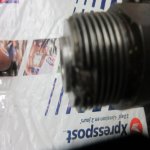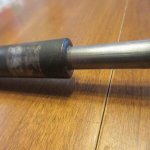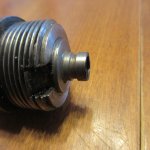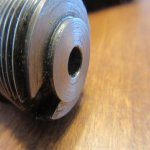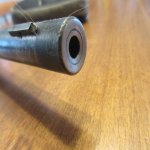This barrel came off a '42 Lithgow which had a damaged receiver. Externally, it isn't bad; internally the bore was rusty.
The barrel was set up in the lathe, and an extended drill was run through. The liner is nominally 5/16" in diameter. The drill more or less cleans out the rifling. The liner drill has a pilot for .22 bores. The pilot is irrelevant for this job
A chamber insert, duplicating the dimensions of a fired .303 case was machined from a scrap of .30 barrel. It was pushed into the chamber and the drill was run through it from the muzzle end.
The liner will now slide through from end to end.
The chamber and insert were degreased, and were coated with epoxy. The liner was driven into the chamber.
After the epoxy has cured, the excess steel will be cut off the insert, and the breech of the barrel will be machined. Note that the chamber insert will be machined so that it projects back into the bolt way, taking up the space where the .303 rim would have resided.
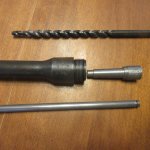
Test assembly, insert in chamber, liner pushed through.
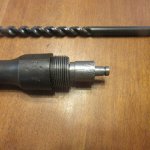
Closeup of the chamber insert. An alternative method is to drill out the chamber and install a plain cylindrical insert. When Parker Hale was lining Lee Enfields, they used a larger diameter liner, and the bore was drilled through from end-to-end.
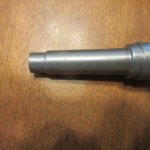
Insert permanently assembled. Epoxy coated and driven into place. Removal of excess material, installation of the liner and final shaping of barrel face come next. The liner will be epoxied in place. Bore and liner degreased, epoxy liberally applied, liner pushed through. Liner will be plugged for this operation, to keep epoxy out of the bore. Once installed on a receiver, final fitting will involve adjusting clearance to the bolt face and chambering. The receiver will be a 1940 BSA dispersal unit.
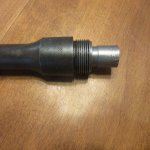
The barrel was set up in the lathe, and an extended drill was run through. The liner is nominally 5/16" in diameter. The drill more or less cleans out the rifling. The liner drill has a pilot for .22 bores. The pilot is irrelevant for this job
A chamber insert, duplicating the dimensions of a fired .303 case was machined from a scrap of .30 barrel. It was pushed into the chamber and the drill was run through it from the muzzle end.
The liner will now slide through from end to end.
The chamber and insert were degreased, and were coated with epoxy. The liner was driven into the chamber.
After the epoxy has cured, the excess steel will be cut off the insert, and the breech of the barrel will be machined. Note that the chamber insert will be machined so that it projects back into the bolt way, taking up the space where the .303 rim would have resided.

Test assembly, insert in chamber, liner pushed through.

Closeup of the chamber insert. An alternative method is to drill out the chamber and install a plain cylindrical insert. When Parker Hale was lining Lee Enfields, they used a larger diameter liner, and the bore was drilled through from end-to-end.

Insert permanently assembled. Epoxy coated and driven into place. Removal of excess material, installation of the liner and final shaping of barrel face come next. The liner will be epoxied in place. Bore and liner degreased, epoxy liberally applied, liner pushed through. Liner will be plugged for this operation, to keep epoxy out of the bore. Once installed on a receiver, final fitting will involve adjusting clearance to the bolt face and chambering. The receiver will be a 1940 BSA dispersal unit.

Attachments
Last edited:



















































